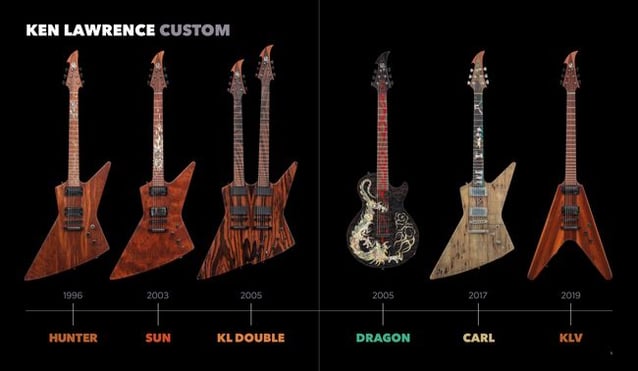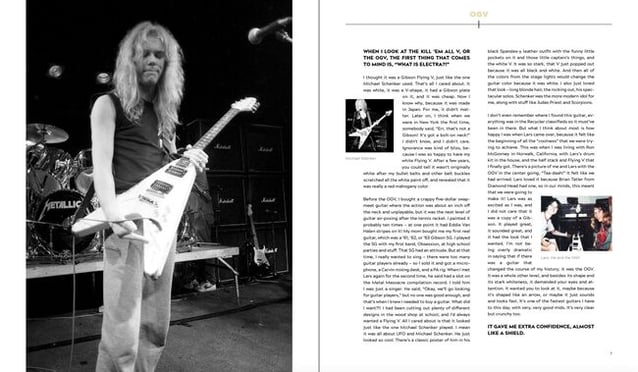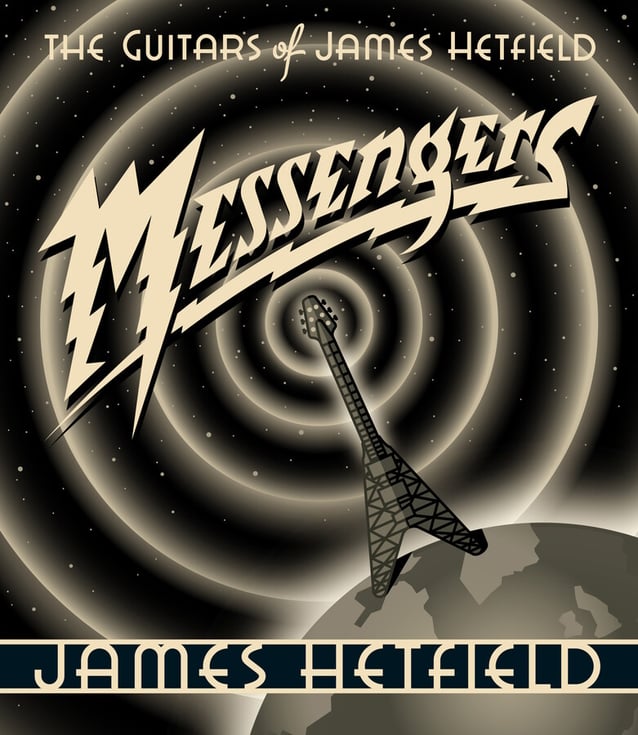During an appearance on the sixteenth episode of “The Metallica Report”, the recently launched podcast offering weekly insider updates on all things METALLICA, James Hetfield spoke about his book “Messengers: The Guitars Of James Hetfield”, which was released on November 21 via Permuted Press. In the 400-page book, Hetfield shares his personal collection of treasured guitars and reveals the story and significance of each within his life and career as the frontman, guitarist and songwriter for METALLICA.
Regarding his decision to release a book about his guitars, Hetfield said (as transcribed by BLABBERMOUTH.NET): “Having the contacts and connections and people that are available to help put out art forms for me that are outside of music… [I] did my car book [‘Reclaimed Rust’], so doing a guitar book was the next thing. And I already had that in my mind, when we were doing the car book and just the way we shot the cars, ‘Reclaimed Rust’ brought up for me an idea of, ‘Hey, I’ve got all these things sitting in my garage. Why can’t I share them with the world or have them in one book for myself to be able to look at and thumb through easily without having to open the garage doors or open the guitar case after guitar case to look at these guitars?’ So kind of have all these guitars put in one book where I can open it and access it very easily.”
As for the “Messengers” book title, James said: “I had so many different titles for it [before I settled on ‘Messengers’]. And ‘Messengers’ just kind of made sense. [My guitars are] the conduit from my higher power through my body, through my digestion, my brain, my fingers into the guitar, through an amp into your ears. It’s a link. It’s a messenger of sorts. And all the guitars that I’ve collected over the years, especially all the early ones, the first 10 years of guitars — from the OGV to the So What to the So Fucking What and Eet Fuk and all the guitars that are named. They’re all named, of course. Same with all the cars. So doing a guitar book — fantastic.”
James also talked about the two “Messengers” book-signing sessions he took part in, in St. Louis and Detroit, earlier in the month. He said: “Well, it was just feel good. It was feel good. People were able to express their gratitude and I was able to do it back. So it was good, good, heartfelt stuff. Seeing multiple generations there is always cool.”
He continued: “I never got to go to gigs with my parents. My older brother brought me to my first gigs, which is — it will always live in my heart as a fantastic memory. So getting to see, whether it’s the kid bringing the parent or vice versa, you get to see that connection and there’s a connection between two generations that I’m just super grateful to be a part of.”
In “Messengers: The Guitars Of James Hetfield”, Hetfield shares the emotional and technical elements of the chosen tools that have shaped his singular musical journey, including exotic instruments, vintage Gibsons, and custom one-offs — from the Electra OGV that defined his style, sound and attitude to the mythical MX guitars, the first in a series of iconic collaborations with ESP, and from his signature Snakebytes through his ambitious projects with renowned luthier Ken Lawrence. He also reveals many studio secrets, including the key amplifiers and gear that sculpt his tone and create his sound.
Each featured guitar is accompanied by lush museum-quality portraits by acclaimed photographer Scott Williamson, exhibiting intimate details one can only see if holding it in their own hands, alongside Hetfield‘s deeply personal reminiscence. Spanning more than forty guitars, ranging from the original battle-scarred road warriors to the trusted studio stalwarts and enduring tour favorites, “Messengers: The Guitars Of James Hetfield” is a meticulously crafted coffee table book and a mesmerizing window into the mind and soul of one of rock’s greatest frontmen. These invaluable guitars have forged over four decades of music history.
A few years ago, Hetfield told Music Radar about his guitar tone: “[It’s] the never-ending quest for the Holy Grail of guitar sounds. For me it’s got to be percussive. It’s got to push air, what we call bark. It’s got to bark. But I don’t want it really abrasive, so any fake fuzz to me really just takes away from the sound. And it’s tough because when you turn guitar sounds down, you really hear what they sound like and when you push them up it sounds a different way. So we’re trying to find that balance of enough mid push while still sounding big and what I’ve found is the wider and bigger you make it sound, the thinner it becomes in a way, at least depth-wise. You’ve got to find your space, elbow your way in there and sonically make some room. And it varies throughout certain songs. The guitar is really important in this song but this one, maybe it’s all about groove. I think we’re learning to be a little more forgiving on each other’s need for volume [laughs] and look at the big picture.”
In a promotional video for Ernie Ball, Hetfield discussed some of his early musical influences, saying: “For me it was a little more raw, the stuff that I liked. Discovering bands like AC/DC, then JUDAS PRIEST, and then the whole New Wave Of British Heavy Metal came out, and that was IRON MAIDEN, then MOTÖRHEAD and BLACK SABBATH, for sure, was a number one influence for me. Seeing that first album cover and seeing that first IRON MAIDEN album cover, it drew me right to it. I just got continually heavier and heavier as I was discovering music.”
Hetfield went on to shed light on the mechanics of his guitar playing: “I’m kind of a little bit of a barbarian when I play. I’m always interested in the riff. It was the foundation of the song. Tony Iommi, he’s ruling the song with his riff and everything else joins him. Johnny Ramone, lots of down picking lots of, you know, just fast down picking. That helped develop my style. So kind of a combination of punk rock and heavy rock at the time turned into just the down-picking style and with melody along with it.”




